SRM-AP All News
ALL News
- Fully automated quality control of rigid and affine registrations of T1w and T2w MRI in Big Data using Machine Learning November 6, 2021
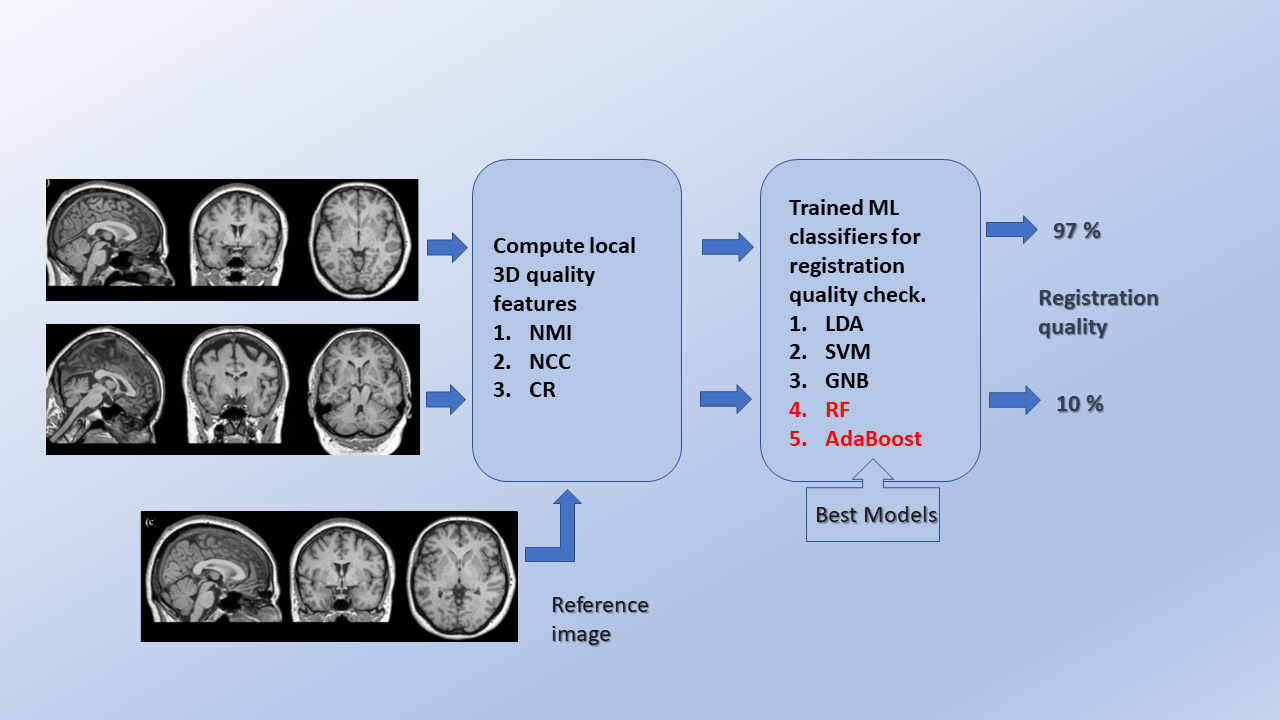 “Research is seeing what everybody else has seen and thinking what nobody else has thought.”
“Research is seeing what everybody else has seen and thinking what nobody else has thought.”
– Albert Szent-Györgyi“Fully Automated Quality Control of Rigid and Affine Registrations of T1w and T2w MRI in Big Data using Machine Learning” is the latest research paper published by Dr Sudhakar Tummala, Assistant Professor, Electronics and Communication Engineering, SRM University-AP in ‘Computers in Biology and Medicine Journal’ having an Impact Factor of 4.6.
Abstract of the paper:
Background: Magnetic resonance imaging (MRI)-based morphometry and relaxometry are proven methods for the structural assessment of the human brain in several neurological disorders. These procedures are generally based on T1-weighted (T1w) and/or T2-weighted (T2w) MRI scans, and rigid and affine registrations to a standard template(s) are essential steps in such studies. Therefore, a fully automatic quality control (QC) of these registrations is necessary for big data scenarios to ensure that they are suitable for subsequent processing.
Method: A supervised machine learning (ML) framework is proposed by computing similarity metrics such as normalized cross-correlation, normalized mutual information, and correlation ratio locally. We have used these as candidate features for cross-validation and testing of different ML classifiers. For 5-fold repeated stratified grid search cross-validation, 400 correctly aligned, 2000 randomly generated misaligned images were used from the human connectome project young adult (HCP-YA) dataset. To test the cross-validated models, the datasets from autism brain imaging data exchange (ABIDE I) and information eXtraction from images (IXI) were used.
Results: The ensemble classifiers, random forest, and AdaBoost yielded the best performance with F1 scores, balanced accuracies, and Matthews correlation coefficients in the range of 0.95-1.00 during cross-validation. The predictive accuracies reached 0.99 on Test set #1 (ABIDE I), 0.99 without and 0.96 with noise on Test set #2 (IXI, stratified w.r.t scanner vendor and field strength).
Conclusions: The cross-validated and tested ML models could be used for QC of both T1w and T2w rigid and affine registrations in large-scale MRI studies.Medical imaging is basically a method to see inside the body non-invasively. Magnetic resonance imaging (MRI) is one of the medical imaging modalities to see inside the body. MRI works on the principles of nuclear magnetic resonance. T1-weighted (T1w) and T2-weighted (T2w) MRI can enable us to see the brain without opening the skull and to monitor brain structural changes that occur in several medical and neurological conditions. It is important to monitor these structural changes over time to understand the disease progression. For example, in Alzheimer’s disease, it is important to monitor the hippocampus (memory storage centre) Recently, due to the advances in computational power such as high-performance GPUs and the availability of publicly accessible big data MRI, scientists around the world now conducting big data research studies. In group-based big data studies, for fair comparison of the brain between healthy and diseased individuals, it is necessary that the brain MRI images are registered to a common coordinate system. Therefore, quality control (QC) of these registrations is necessary to ensure that they are suitable for further processing. Further, in big data studies that involve several thousands of images, manual QC is not feasible and hence there is a need for a fully automated QC mechanism at the pre-processing stage. Checking the quality of rigid and affine registrations is one such task.
The research group implemented a fully automated QC mechanism based on computing several quality metrics local to the image and trained several machine learning classifiers based on these locally computed quality measures. The trained classifiers include linear discriminant analysis, support vector machine, Gaussian naïve Bayes, random forest and adaptive boosting. The developed ML models generalize well to detect misaligned registrations across different MRI scanner vendors and field strengths and even under noisy image situations. Therefore, the classifiers could be employed in big data studies for fully automated QC of registrations, especially T1w and T2w MRI.
Big data MRI studies are generally conducted using a large number of subjects. The conclusions drawn based on big data analysis are more reliable and help to understand the disease mechanics better. The developed method can help to reduce the manual labour for various QC mechanisms required during the pre-processing stage.This work is done in collaboration with
a. Prof Erik B Dam, Machine Learning Group, University of Copenhagen, Copenhagen, Denmark.
b. Prof Niels K Focke, Clinic for neurology, University Medical Centre, Göttingen, Germany.In future, the idea is to implement the QC framework using sparse autoencoders in an unsupervised manner and also using Siamese neural networks via deep representation learning.
Continue reading → - High bars of predecessors for high marches of successors November 5, 2021
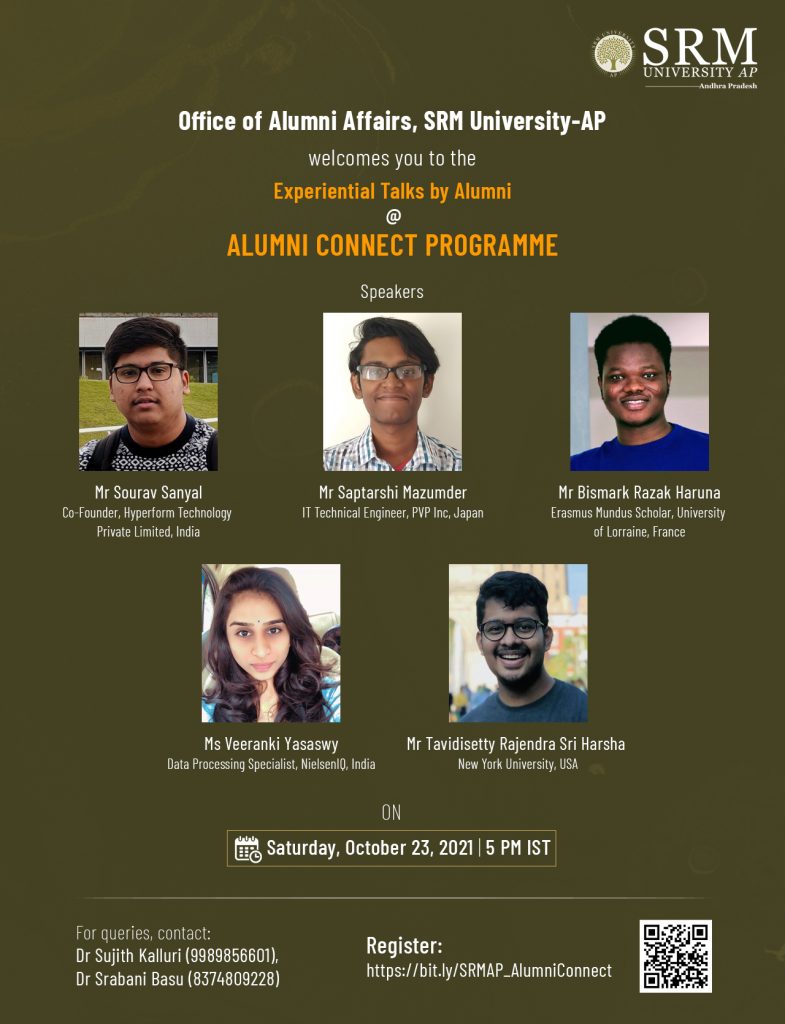 We bid adieu to the maiden batch with interesting placements and higher education opportunities in hand. Their farewell was as glorious as it was tearful. On October 23, 2021, SRM University-AP welcomed them back with the intention to aid the current students. In a colourful online ceremony, President Dr P Sathyanarayanan inaugurated the Alumni Connect Programme to help our students stay connected, even after graduation.
We bid adieu to the maiden batch with interesting placements and higher education opportunities in hand. Their farewell was as glorious as it was tearful. On October 23, 2021, SRM University-AP welcomed them back with the intention to aid the current students. In a colourful online ceremony, President Dr P Sathyanarayanan inaugurated the Alumni Connect Programme to help our students stay connected, even after graduation.In his inaugural speech, Dr P Sathyanarayanan congratulated the graduate students for the rigorous years of studies and the many laurels that they have brought to their alma mater. He further expressed his beliefs that this kind of networking programme will bring the students closer and skillfully aid the existing students in their search for the best jobs, higher studies and other opportunities. “The founding batch has set the bar so high that the following batches will need to strive really hard to make their mark,” asserted Dr Sathyanarayan.
The event progressed with messages from Prof V S Rao, Vice-Chancellor, SRM University-AP and Prof D Narayana Rao, Pro-Vice-Chancellor, SRM University-AP. The eminent dignitaries launched the Alumni Yearbook-2021.
The event sprang to life with the jovial conversations between the alumni and the current students. The current students shared their fears and anxiety with their seniors, while our alumni shared their journey.
Listening to the alumni helped the current students be more confident and focused. The insights shared by the seniors helped the juniors plan their the academic and career trajectories more adequately.
The alumni also reminisced about their time at the University. They guided the current students on making the best use of all the state-of-the-art facilities that the University offers. In addition to that, they taught their juniors about managing academic studies and other activities without compromising with all the fun of college life.
The vigorous event came to an end with the facilitation ceremony by Ms Revathi B, Assistant Director, Student Affairs. Dr Sujith Kalluri, Assistant Director, Alumni Affairs, offered a concluding speech to mark the closing of the event.
Continue reading → - STIP- 2020: “Impartial inclusion will make India global scientific superpower” October 30, 2021
“India is moving towards ‘technological self-reliance’ and will emerge as one of the ‘Top 3 scientific superpowers’ through Science, Technology and Innovation Policy (STIP) 2020: A Transformative Science and Technology Agenda,” said Dr Sandeep Verma, Secretary of Science and Engineering Research Board (SERB), in the thirteenth edition of University Distinguished Lecture Series conducted by SRM University-AP, Andhra Pradesh on October 30, 2021.
The objectives of the Distinguished Lecture were enumerated by the Pro-Vice-Chancellor, Prof D Narayana Rao. He further said that the STIP: 2020 will greatly enhance the scientific contributions of Universities, Institutions and National Laboratories. He said that Universities and Institutions are hubs for innovations.
Dr Verma, a recipient of one of the highest Indian awards in the field of Science, the Shanti Swarup Bhatnagar Prize, is known for his contributions towards experimental medicine by working in the areas of bio-chemical interface. Prof Verma felt that the vision behind STIP: 2020 can only be executed through innovative, collaborative, and open science research that is best implemented in Universities and Educational Institutions like SRM University-AP.
Dr Verma elucidated that the primary idea behind STIP: 2020 is Inclusivity. STIP: 2020 will require an uninhibited and indiscriminate free flow of scientific and innovative ideas between all the people with a scientific interest from the Indian diaspora and from rural India, from all genders, from all age groups ignoring any disability physical or otherwise. “We can’t afford to leave anyone behind”, Dr Verma said referring to India’s quest to become a scientific and technological superpower. Prof Sandeep Verma said that the gross spending of the country on R & D increased 3 times during the last 8 years.
Appreciating the efforts made by SRM University-AP, Dr Verma emphasised the need to have the researchers coming out in the open, solving real-life problems and making every individual Indian life better. “It is our Scientific Social Responsibility to conduct such open forums for scientific communication and understanding,” he said, “As India prepares to grow towards technological self-reliance and indigenisation with the support of various schemes under Atmanirbhar Bharat and develop an ecosystem worthy of global benchmark, STIP: 2020 comes as a landmark innovation policy at this crucial juncture.”
Dr Verma ended his talk with the hopeful note that other Universities would follow the example of SRM University-AP and make such conscientious efforts towards innovation to make lives better. The lecture was attended by Dr S Chandrasekhar, Director, CSIR-IICT and over 2300 members from several premier institutions like IITs, NITs, IISERs, Universities and Institutions, CSIR, DST, DBT, DRDO, DAE, ISRO, NARL, MoES and several others from different parts of the country.
Prof V S Rao, Vice-Chancellor and Prof D Narayana Rao, Pro-Vice-Chancellor felicitated Prof Sandeep Verma and presented him with a memento.
Continue reading → - BSc Physics student contributes as the First Author for a research paper October 29, 2021
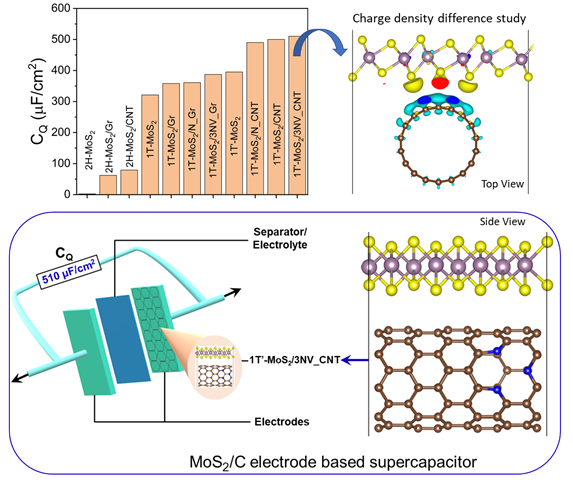 A research paper titled “First Principle Identification of 2D-MoS2 based Composite Electrodes for Efficient Supercapacitor Application” is published by Samadhan Kapse, PhD student, as First Author and Bennet Benny, BSc Physics Student, (Same Contributed First Author) in the Journal of energy storage, Elsevier having an Impact Factor of 6.583. The paper publication has been guided and supervised by Dr Pranab Mandal (Co-Author) and Prof Ranjit Thapa (Corresponding Author) from the Department of Physics, SRM University-AP.
A research paper titled “First Principle Identification of 2D-MoS2 based Composite Electrodes for Efficient Supercapacitor Application” is published by Samadhan Kapse, PhD student, as First Author and Bennet Benny, BSc Physics Student, (Same Contributed First Author) in the Journal of energy storage, Elsevier having an Impact Factor of 6.583. The paper publication has been guided and supervised by Dr Pranab Mandal (Co-Author) and Prof Ranjit Thapa (Corresponding Author) from the Department of Physics, SRM University-AP.1T Molybdenum disulfide (1T-MoS2) has been widely studied experimentally as an electrode for supercapacitors due to its excellent electrical and electrochemical properties. Whereas the capacitance value in MoS2 is limited due to the lower density of electrons near the Fermi level, and unable to fulfil the demand of industry i.e. quantum capacitance preferably higher than 300 μF/cm2. Here, we investigated the performance of 2H, 1T, and 1T’ phases of MoS2 in its pristine form and heterostructures with carbon-based structures as an electrode in the supercapacitors using density functional theory. Specifically, we reported that the underneath carbon nanotube (CNT) is responsible for the structural phase transition from 1T to 1T’ phase of MoS2 monolayer in 1T’-MoS2/CNT heterostructure. This is the main reason for a large density of states near the Fermi level of 1T’-MoS2/CNT that exhibits high quantum capacitance (CQ) of 500 μF/cm2 at a potential of 0.6 V. Also, we observed that the nitrogen doping and defects in the underneath carbon surface amplify the CQ of heterostructure for a wider range of electrode potential. Therefore, the 1T’-MoS2 /N doped CNT can be explored as an electrode for next-generation supercapacitors.
Today’s increasing demand for energy storage technologies is highly dependent on batteries, fuel cells, supercapacitors, etc. The supercapacitors are greatly efficient due to advantages such as high power density, wide operating temperature range, large charge-discharge cycles. The recent focus of researchers is to find promising electrode materials for supercapacitor application. Among all reported works, the MoS2 nanosheet is found to be a prime candidate for supercapacitors with a high power density as well as energy density. Therefore, it is important to understand the origin of capacitance in MoS2 and their composites to design promising electrodes for supercapacitors. Also, the identification of ideal MoS2 based composites for efficient supercapacitor application is a grand challenge using only experimental approaches.
Using density functional theory, we can identify the promising electrode materials for supercapacitor application based on various graphene, 2D metal chalcogenides and their heterostructures. The quantum capacitance (CQ) is the cost-effective method to estimate the performance of any low density of states materials such as graphene, MoS2, etc towards supercapacitors.
Continue reading → - World’s top 2% scientists by Stanford University include faculty from SRM University-AP October 26, 2021
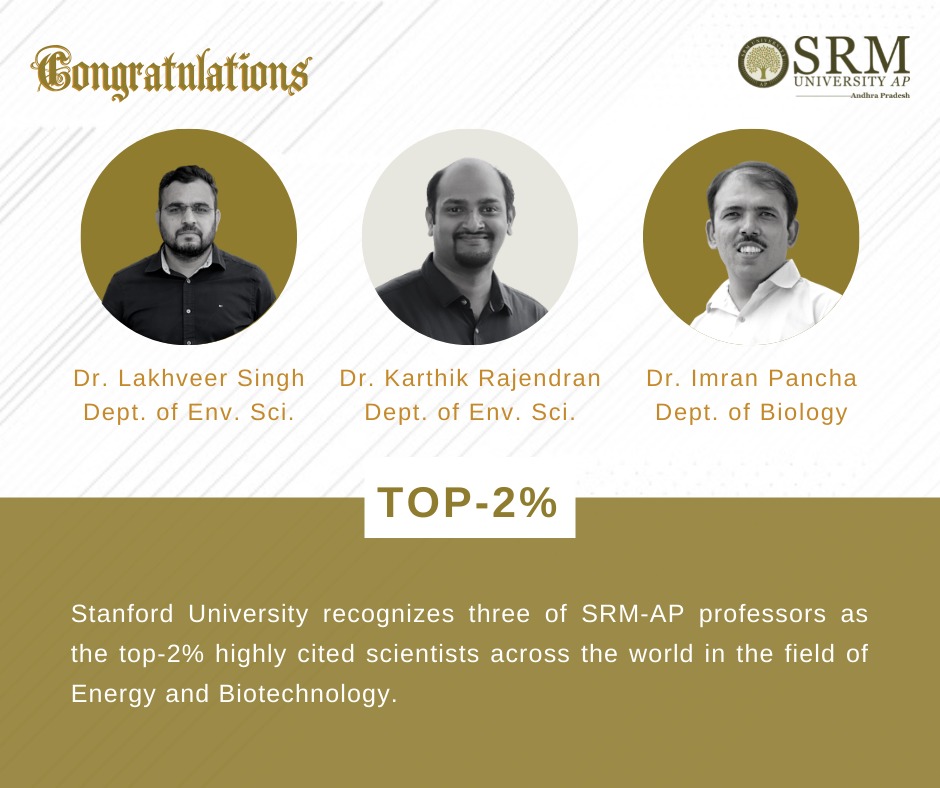 Dr Karthik Rajendran, and Dr Lakhveer Singh from the Department of Environmental Science and Dr Imran Pancha from the Department of Biological Sciences of SRM University-AP are enlisted on the global list of the top 2% of scientists, the data compiled by Stanford University.
Dr Karthik Rajendran, and Dr Lakhveer Singh from the Department of Environmental Science and Dr Imran Pancha from the Department of Biological Sciences of SRM University-AP are enlisted on the global list of the top 2% of scientists, the data compiled by Stanford University.Stanford University has identified Dr Imran Pancha as one of the 91 scientists who has excelled in research in the fields of biotechnology among all the universities in India. Dr Imran Pancha was recognised as one of the top 2% scientists in the world in the year 2020 also. Stanford University recognized 178 scientists who excelled in research in the field of energy, which includes Dr Karthik Rajendran and Dr Lakhveer Singh among the top 2 per cent of scientists. The quality of research work, its societal impact, number of publications, citations, are taken into consideration for this recognition.
University Vice-Chancellor Prof V S Rao and Pro-Vice-Chancellor Prof D Narayana Rao presented Certificates of Recognition to the three professors at a congratulatory function held at the university on Friday. “This is an admirable achievement that young faculty from a nascent University appear in the top 2% scientists of the world,” said Prof D Narayana Rao. Prof V S Rao Narayana Rao appreciated their talent and efforts. Prof Narayana Rao assured them that the university would provide the necessary comprehensive support for carrying out research in front-line and emerging areas. Prof Narayana Rao further said that he is very confident that many more faculty members of SRM University – AP, will receive such global recognition in the years to come.
Continue reading → - Exciting dream salary in dream company BARCLAYS October 22, 2021
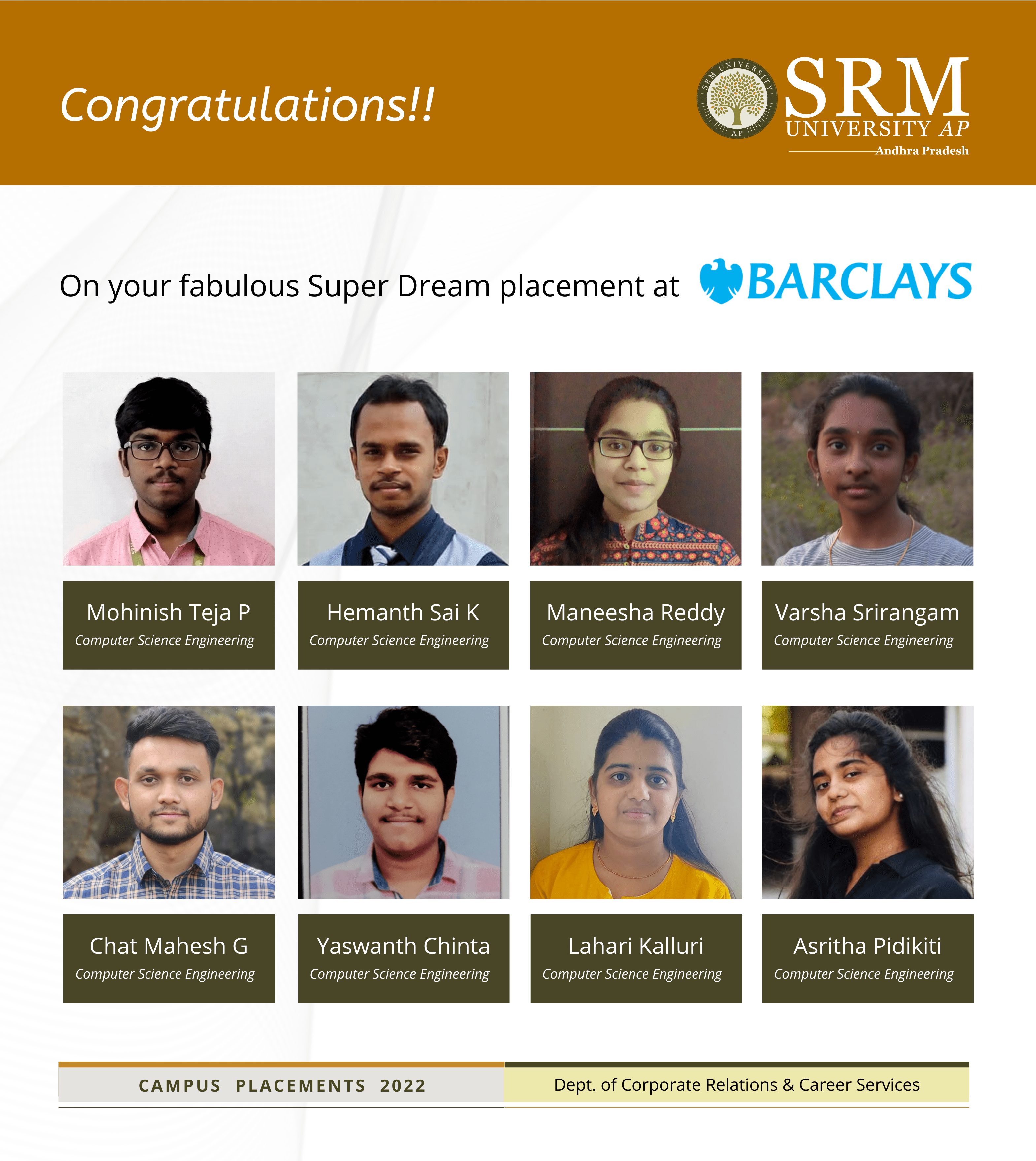 8 students with exciting job offers to their name from world-renowned Barclays Multinational Bank shine up on SRM University-AP banner. Thriving in a competitive environment and levelling themselves up with their goals, these students were able to not only show their polished skills but also their refined mannerisms at expressing it. Their smart work at making best use of the versatile courses offered to them by SRM University-AP has helped them land the job of their dreams.
8 students with exciting job offers to their name from world-renowned Barclays Multinational Bank shine up on SRM University-AP banner. Thriving in a competitive environment and levelling themselves up with their goals, these students were able to not only show their polished skills but also their refined mannerisms at expressing it. Their smart work at making best use of the versatile courses offered to them by SRM University-AP has helped them land the job of their dreams.Barclays is a coveted dream company for Engineers in India. The Placement Cell at SRM University-AP, CR&CS (Corporate Relations and Career Services) realizes that for specific job roles specific skills would have to be cultivated and the students would need outstanding training along with their academia to fill these roles. The CR&CS counsels the students accordingly so that by the time they sit for the interview they carry the confidence of being the perfect fit for the role.
Maneesha Reddy
“Stop doubting yourself, work hard and make it happen. This is what SRM University-AP taught me. The ISCP course by the CCC department included in the academics helped me become better every day and improved my skills in coding and logical thinking. The training classes provided for the placement and the talks with the experts organised by the CR&CS department helped me know the overview of the placement process. Faculty members really helped us to improve, especially our HOD, Dr Raghunathan, has been the best support to all things associated with the CSE Department. My advice to my juniors is to stay focused on your work, be confident, and follow the curriculum set by the placement department.”Gunturu Hemanth Sai Kumar
“SRM University-AP curriculum provided a wonderful environment for building up my basics and it also helped me in achieving higher CGPA. The bootcamps and ISCP classes conducted by CCC department provided me the exposure to different company specific problems and improved my problem-solving skills. Placement department also provided me with opportunities by bringing in various companies and that experience helped me clear the interviews. I even got shortlisted for interviews of Marquee and super dream companies like Wells Fargo, NielsenIQ, Navis, Sabre which provided me great exposure to interview handling skills.”Asritha Pidikiti
“SRM University-AP is a place where you can find an amalgamation of learning, fun, culture, many such life preaching activities. Various workshops and sessions that were held in the University, improved my technical as well as interpersonal skills. My knowledge and confidence go a boost after coming here. SRM University-AP has given me a chance to participate in various committees which helped me to broaden my network. The placement cell has excellent policies and has exceptionally helped me build an industry-ready profile, by arranging seminars and holding aptitude- development lectures.”Chinta Yaswanth
“I am very glad to start my career with Barclays This could come to pass because CR&CS dept supported us a lot by conducting multiple mock tests. Especially, thanks to the company specific sessions before the drive. These sessions before the drive made all the difference and assured us to face an interview. I whole-heartedly appreciate the virtual help desk despite of the covid situation. I would suggest my juniors to be good at their basics and follow the inputs given by placement team.”Kalluri Lahari
“You never change your life until you step out of your comfort zone; change begins at the end of your comfort zone.
“I still remember when I joined this university, being a person who used to be shy and introvert, and today, I am here holding an offer would not have been possible without the support from SRM University-AP. The coursework provided by CR&CS department, CDC and domain training helped me to achieve this offer. The CDC department guidance assisted us in improving communication skills and teamwork. Approximately 65 companies lined up for recruitment in a month. SRM University provided us with countless opportunities to fulfil our goals. My advice for the juniors would be to not postpone everything to the last-minute because this might stop you from achieving your dreams.”Srirangam Varsha
“The curriculum containing industry specific training, mock interviews and group discussions along with company specific training made it easier for us throughout the placement drive. We were familiar with the concepts asked in our coding and interview rounds thanks to the training sessions provided by the CR&CS department. The encouragement I received from my faculty and mentor really helped me when I was at my lowest. I would like to take this chance to thank all my faculty, seniors and CR&CS department because of whose help I did not feel any burden throughout my placement drive and achieved great results. I would suggest to my juniors to take advantage of inputs provided by management to fulfil your dreams and achieve higher heights.”Paturi Mohinish Teja
“I am very happy to get placed at Barclays. I used to dream about getting placed at a FinTech institution and am very glad to achieve it. Curriculum at SRM University-AP helped me in learning all the required computer fundamentals. CCC training organised by the placement department has helped me a lot during my preparation for placements and interviews. I have been part of Next Tech Lab, which helped me learn a lot of things and build many projects. These projects helped me in Interview. My advice to Juniors would be to build a strong portfolio and never give up in the middle.”SRM University-AP is proud of their achievements and would like to wish them all the success in their lives as their alma-mater.
Continue reading → - Securing Online Payments made through Wearable Devices October 20, 2021
Smart devices and Internet of Things (IoT) are growing in importance every day and so do our security concerns about using them for our financial transactions. As we carry the world with us through wearable technology, Dr Sriramulu Bojjagani, Assistant Professor, Department of Computer Science Engineering works towards making wearable devices more secure.
With a thriving interest in Cyber Security, Formal Verification Methods and Vulnerability Analysis and Penetration Testing, Dr Bojjagani has recently published his paper on “A Secure IoT-based Micro-payment Protocol for Wearable Devices” in Peer-to-Peer Networking and Applications (PPNA), Springer.DOI: 10.1007/s12083-021-01242-y
Abstract:
Wearable devices are one of the parts of the essential cost of goods sold (COGS) in the wheel of the Internet of things (IoT), contributing towards a potential impact in the finance and banking sectors. There is a need for lightweight cryptography mechanisms for IoT devices because these are resource constraints. This paper introduces a novel approach to an IoT-based micro-payment protocol in a wearable device’s environment. This payment model uses “elliptic curve integrated encryption scheme (ECIES)” for encryption and decryption of the communicating messages between various entities. The proposed protocol allows the customer to buy the goods using a wearable device and send the mobile application’s confidential payment information. The application creates a secure session between the customer, banks, and merchant. The static security analysis and informal security methods indicate that the proposed protocol is withstanding the various security vulnerabilities involved in mobile payments. For logical verification of the correctness of security properties using the formal way of “Burrows-Abadi-Needham (BAN)” logic confirms the proposed protocol’s accuracy. The practical simulation and validation using the Scyther and Tamarin tool ensure the absence of security attacks in our scheme. Finally, the performance analysis based on cryptography features and computational overhead of related approaches specify that the proposed micro-payment protocol for wearable devices is secure and efficient.
Architecture for wearable devices:
The architecture for wearable devices is shown in Fig. 1. It consists of six types of entities, such as Issuer bank (IB), acquirer bank (AB), payment gateway (PG), a certification authority (CA), mobile terminal, and wearable sensing devices. The person using various wearable devices such as a smartwatch, smart wristband, smart glass, etc. In the architecture, a wearable device is connected to the mobile terminal through NFC. An app is running on a mobile device. Wearable devices are resource constraints because they have limited computing capabilities regarding battery, display, storage, and processing compared to a mobile terminal (smartphone). Hence, NFC is used to pair the wearable device and mobile terminal for transmitting public messages. Before conducting any transaction with the merchant, the customer and merchant should register their mobile numbers with the bank.
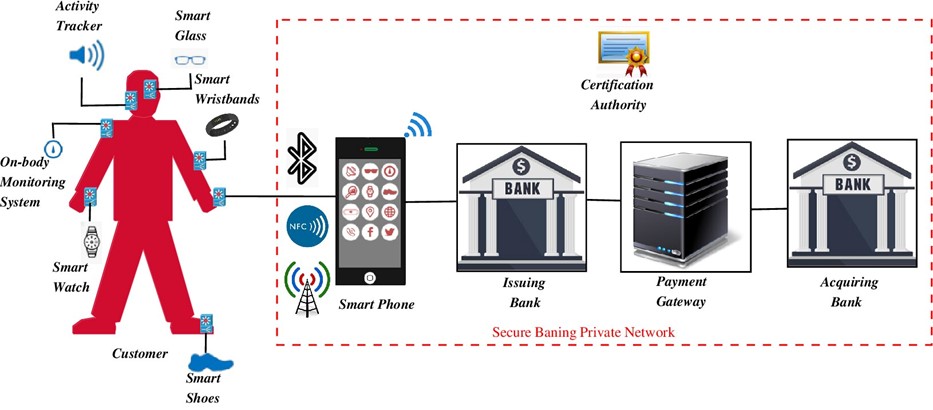
Fig. 1. Architecture for wearable devices
The customer can place an order with the merchant using the following steps and the complete messages flow in the proposed protocol is shown shown in the Figure.
● The customer places an order for an item through a wearable device.
● The request is transferred to the mobile app. The mobile app verifies the user authentication.
● After a successful authentication request, the app forwarded the request to the issuing bank for payment verification.
● The customer also sends a payment request for a deduction of the amount from his/her issuing bank.
● Once the bank validates the customer data in terms of sufficient funds available and user’s integrity. The issuing bank routes the transaction to the payment gateway through a secure network.
● In this step, the payment gateway verified the customer payment order and transferred it to the acquiring bank.
● If all the verifications are successful, then the transaction amount is then debited from the issuing bank and credited to the merchants’ acquiring bank.

Application demonstration:
As we know, most wearable devices run the Android operating system. The proposed framework developed as an Android application package (APK) file run in an Android wearable emulator, but we have operated in the Samsung Galaxy Note-2 device due to limits of the screen device and lack of environment. First, it needs to install the APK file and start running the app. Before running the app, some points need to be considered, such as the following:
● The company voice gateway provided for the service of an SMS gateway connected to Xeon server and assigned us a shortcode 56677.
● The payment gateway switch is used to communicate with the customer and merchant bank accounts.
● Two mobile numbers are registered with the banks and telecom operations, and it is used for SMS service.
● The deployed decryption web application on the Xeon server.
● HTTPS connection is used between voice gateway and Xeon server established Indian financial network (INFINET) link between server and bank.
We have not mentioned all the screenshots for the app from starting the login and authentication phase, but the protocol requires the essential information only shown in the screenshot. We didn’t mention the banks considered for implementing the micro-payment protocol for security and reputation reasons.
The proposed protocol action is as follows:
Step 1: The customer x runs a wearable application to enter Wearable-id, mobile number, pin and amount and sends an encrypted message to the Xeon server via short-code 56677. To encrypt the message, the customer may choose any one of the ECC curves as shown in Fig. 2.

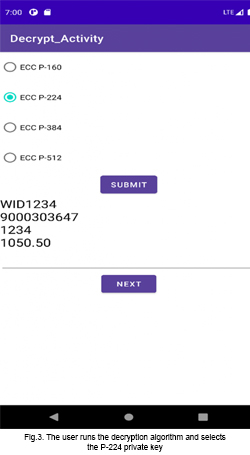
Step 2: The SMS gateway receives the encrypted SMS, which is delivered to the server
Step 3: The server receives the encrypted SMS and executes the decryption application. Next, the user runs decryption activity and selects the P-224 private key. After decryption, the message is shown in Fig. 3.
Step 4: After the message is decrypted, the user presses the “Next” button to communicate with the payment gateway.
Step 5: Now, the merchant fills in the remaining fields of merchant UPI-id, mobile number, and purpose of payment and then selects any payment gateway as shown in Fig. 4.

Fig. 4: The merchant enters the details and sends to any payment server
Dr Bojjagani’s research will further refine the parameters of security in IoT enabling wearable devices to become smarter and safer.
- To make the proposed protocols more secure can add biometric-based authentication can be added.
- The future directions of the proposed framework fit only for micro-payments. In future, we have upgraded to credit card/debit card payments to enhance the proposed framework for macro-payments.
- Impact of Surface Chemistry on the Excited State Interactions of CsPbBr3 October 20, 2021
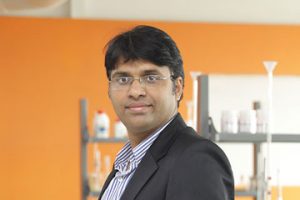 Dr Nimai Mishra, Assistant Professor, Department of Chemistry, SRM University-AP along with his team comprising of his PhD scholars Mr. Syed Akhil, Ms. V.G.Vasavi Dutt, and Mr Rahul Singh have published a research article titled “Surface-State-Mediated Interfacial Hole Transfer Dynamics Between CsPbBr3 Perovskite Nanocrystals and Phenothiazine Redox Couple” in The Journal of Physical Chemistry-C, published by The American Chemical Society with an impact factor of ~4.126.
Dr Nimai Mishra, Assistant Professor, Department of Chemistry, SRM University-AP along with his team comprising of his PhD scholars Mr. Syed Akhil, Ms. V.G.Vasavi Dutt, and Mr Rahul Singh have published a research article titled “Surface-State-Mediated Interfacial Hole Transfer Dynamics Between CsPbBr3 Perovskite Nanocrystals and Phenothiazine Redox Couple” in The Journal of Physical Chemistry-C, published by The American Chemical Society with an impact factor of ~4.126.Dr Mishra’s research interests lie in Semiconductor nanocrystals, Core/shell branched structures, Nanowires, Perovskite nanocrystals and Optoelectronic device fabrication. He studied the role of surface chemistry for improving excited state hole transfer from CsPbBr3 nanocrystals to an acceptor, potentially applicable for photocatalytic applications.
About the research:
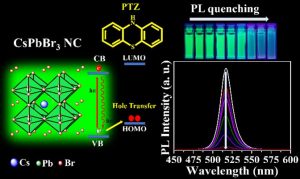 Recently, caesium lead bromide (CsPbBr3) perovskite nanocrystals (PNCs) gained enormous attention for designing photocatalytic reactions because of their photocatalytic properties. But the surface chemistry of nanocrystals is often ignored which dictate the excited state interactions of these semiconductor nanocrystals with the charge shuttling redox-active molecules. In this work, we have explored the impact of CsPbBr3 perovskite nanocrystals with the three different surface chemistries on the excited state interactions with the standard hole acceptor phenothiazine molecule. From the steady PL-lifetime decay measurements we have calculated the photoinduced hole transfer (PHT). In the amine-free PNCs case, PHT is 6 times higher than the conventional amine capped ligands. Using the lifetime fast component (1) rate constants, we have calculated the hole transfer constant (kht) which is 3.942 × 108 s-1 and it is 4 times higher in amine-free ligands when compared with conventional amine ligands system.
Recently, caesium lead bromide (CsPbBr3) perovskite nanocrystals (PNCs) gained enormous attention for designing photocatalytic reactions because of their photocatalytic properties. But the surface chemistry of nanocrystals is often ignored which dictate the excited state interactions of these semiconductor nanocrystals with the charge shuttling redox-active molecules. In this work, we have explored the impact of CsPbBr3 perovskite nanocrystals with the three different surface chemistries on the excited state interactions with the standard hole acceptor phenothiazine molecule. From the steady PL-lifetime decay measurements we have calculated the photoinduced hole transfer (PHT). In the amine-free PNCs case, PHT is 6 times higher than the conventional amine capped ligands. Using the lifetime fast component (1) rate constants, we have calculated the hole transfer constant (kht) which is 3.942 × 108 s-1 and it is 4 times higher in amine-free ligands when compared with conventional amine ligands system.According to Dr Nimai Mishra, the most important contribution of this research is that these results highlight the impact of surface chemistry on the excited state interactions of CsPbBr3 PNCs and conclude amine-free PNCs could be an ideal candidate for photocatalytic reactions.
Read the full paper: https://pubs.acs.org/doi/10.1021/acs.jpcc.1c07129
Continue reading → - Better Kinetics with MXene-based Electrocatalysts in Fuel Cells October 8, 2021
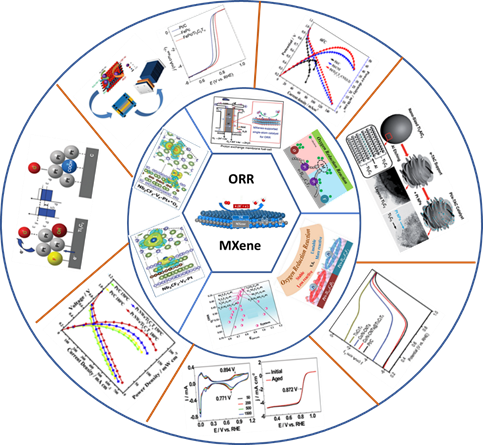 A cutting-edge research paper on MXene-based electrocatalysts for fuel cells has been published by Dr Lakhveer Singh of the Department of Environmental Sciences. In the journal of Advanced Materials Interfaces, Impact factor 6.14, his paper, titled “Recent Advances on MXene-Based Electrocatalysts toward Oxygen Reduction Reaction: A Focused Review”, has been published in collaboration with Dr S. G. Peera and Dr. T. G. Lee from the Department of Environmental Science and Engineering Keimyung University Daegu 42602, Republic of Korea.
A cutting-edge research paper on MXene-based electrocatalysts for fuel cells has been published by Dr Lakhveer Singh of the Department of Environmental Sciences. In the journal of Advanced Materials Interfaces, Impact factor 6.14, his paper, titled “Recent Advances on MXene-Based Electrocatalysts toward Oxygen Reduction Reaction: A Focused Review”, has been published in collaboration with Dr S. G. Peera and Dr. T. G. Lee from the Department of Environmental Science and Engineering Keimyung University Daegu 42602, Republic of Korea.Oxygen reduction reaction (ORR) takes place in the fuel cells. Improving the kinetics of the reaction would be a major step in improving the efficiency of the fuel cells. Extensive studies have been done to find cathode catalysts that are both highly active and also maintain stability in a corrosive environment. Recent research has been leaning towards 2D materials owing to the larger surface area they provide for catalyst dispersion. MXene-based catalysts have become popular due to their impressive electrical conductivity as well as their thermal and chemical stability.
A summary of Dr Singh’s paper:
MXene, a novel transition metal carbide and/or nitride based two-dimensional material has been gaining a considerable interest in the field of energy storage and conversion, due to their unique layered structure, electronic properties, and surface chemistry, that are beneficial for various electrochemical reactions. Most of the MXenes research done so far is in the field of supercapacitors, batteries, overall water splitting, and other catalytic applications. The research done on fuel cell cathodic oxygen reduction reaction (ORR) is scarce. There is a need for intensive review on Mxenes. Uniquely, this review article describes the ORR catalysis of MXene based catalysts both in theoretical and experimental view.
In future they plan to work on investigations on theoretical and computational screening to elucidate the ORR mechanism, stability, and strategies for improving the electrocatalytic activity of MXene catalysts; these studies can serve as a guide for experimentalists, especially for selecting optimal catalyst compositions.
Continue reading → - Pavan Mohan wins TATA InnoVerse SolverHunt Challenge bagging Rs.25,000 October 7, 2021
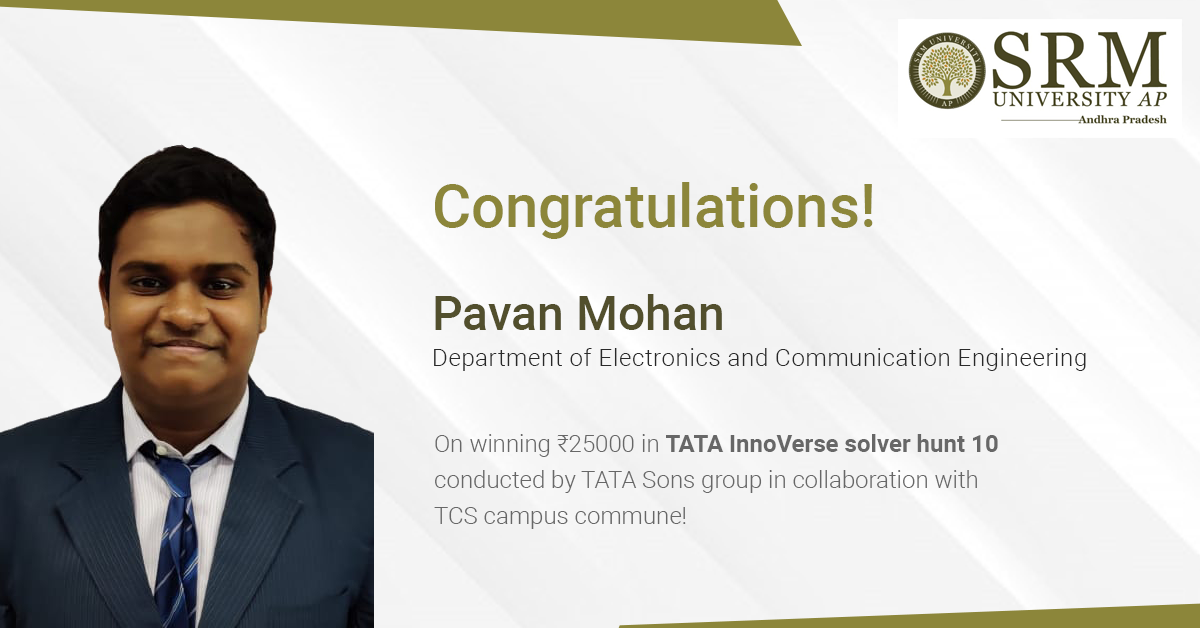 SRM University-AP is proud to announce that Pavan Mohan Neelamraju, a student of the Department of Electronics and Communication Engineering (ECE) has shown extraordinary problem-solving abilities and won the TATA InnoVerse SolverHunt 10 and has been rewarded with Rs. 25,000.
SRM University-AP is proud to announce that Pavan Mohan Neelamraju, a student of the Department of Electronics and Communication Engineering (ECE) has shown extraordinary problem-solving abilities and won the TATA InnoVerse SolverHunt 10 and has been rewarded with Rs. 25,000.The TATA InnoVerse SolverHunt poses challenges to aspiring innovative students in the fields of scientific and technological research. The students are required to come up with solutions individually and the most viable solutions are rewarded with exciting cash prizes, certificates of recognition and an invaluable opportunity to learn from experts in the industry.
Pavan’s challenge in the TATA InnoVerse SolverHunt was to classify steel wire bundles based on their shining appearance. Pavan developed an algorithm which quantified the gloss in the image using image processing and machine learning techniques. The algorithm went through three rounds of rigorous evaluation before being declared best.
Though Pavan worked on his solutions all by himself adhering to the guidelines of the TATA InnoVerse SolverHunt, he believes his vastly flexible course choices helped him a lot. The knowledge and perspective he gained in “Artificial Intelligence and Machine Learning” coupled with the hands-on experience he acquired while working on cutting edge technology as a part of Next Tech Lab at SRM AP enabled him to make vital winning decisions.
“The academic work has actually helped me to think out of the box and to imagine a wide range of possibilities to a single problem,” Pavan thanked Dr Ramesh (HOD ECE) and Prof. Siva Shankar along with the faculty of ECE Department for grooming him. In industrial problems such as the ones provided by TATA InnoVerse SolverHunt Pavan was able to implement machine learning and image processing which he had learnt in classroom.
We, the SRM Family, wish Pavan luck for all his future endeavours and plans which include obtaining a doctorate degree as well as working in teaching and research fields. Winning TATA InnoVerse SolverHunt is the first step on the path of recognition for him. We are extremely pleased that he could serve as an inspiration to all the students out there.
Continue reading →

